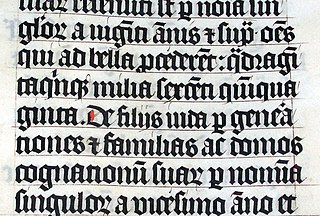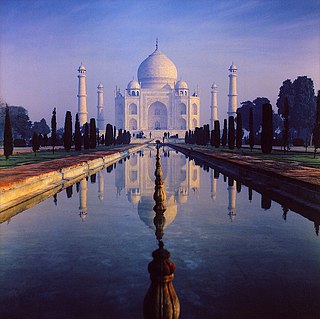
Arabic calligraphy is the artistic practice of handwriting and calligraphy based on the Arabic alphabet. It is known in Arabic as khatt, derived from the word 'line', 'design', or 'construction'. Kufic is the oldest form of the Arabic script.

The Brahmic scripts are a family of abugida writing systems. They are used throughout the Indian subcontinent, Southeast Asia and parts of East Asia, including Japan in the form of Siddhaṃ. They are descended from the Brahmi script of ancient India, and are used by languages of several language families: Indo-European, Dravidian, Tibeto-Burman, Mongolic, Austroasiatic, Austronesian, and Tai. They were also the source of the dictionary order (gojūon) of Japanese kana.

Calligraphy is a visual art related to writing. It is the design and execution of lettering with a broad tip instrument, brush, or other writing instruments. A contemporary calligraphic practice can be defined as "the art of giving form to signs in an expressive, harmonious, and skillful manner".

Blackletter, also known as Gothic script, Gothic minuscule, or Textura, was a script used throughout Western Europe from approximately 1150 until the 17th century. It continued to be used for the Danish language until 1875, and for German, Estonian and Latvian until the 1940s. Fraktur is a notable script of this type, and sometimes the entire group of blackletter faces is incorrectly referred to as Fraktur. Blackletter is sometimes referred to as Old English, but it is not to be confused with the Old English language, which predates blackletter by many centuries and was written in the insular script or in Futhorc.

Nastaʿlīq is one of the main calligraphic hands used in writing the Persian alphabet and traditionally the predominant style in Persian calligraphy. It was developed in Iran in the 14th and 15th centuries. It is sometimes used to write Arabic language text, but its use has always been more popular in the Persian, Urdu, and Turkic sphere of influence. Nastaʿlīq remains very widely used in Iran, Afghanistan, and India and other countries for written poetry and as a form of art.

Islamic calligraphy is the artistic practice of handwriting and calligraphy, based upon the alphabet in the lands sharing a common Islamic cultural heritage. It includes Arabic Calligraphy, Ottoman, and Persian calligraphy. It is known in Arabic as khatt Islami, meaning Islamic line, design, or construction.

Chinese calligraphy is the writing of Chinese characters as an art form, combining purely visual art and interpretation of the literary meaning. This type of expression has been widely practiced in China and has been generally held in high esteem across East Asia. Calligraphy is considered as one of the four best friends of ancient Chinese literati, along with playing stringed musical instruments, the board game "Go", and painting. There are some general standardizations of the various styles of calligraphy in this tradition. Chinese calligraphy and ink and wash painting are closely related: they are accomplished using similar tools and techniques, and have a long history of shared artistry. Distinguishing features of Chinese painting and calligraphy include an emphasis on motion charged with dynamic life. According to Stanley-Baker, "Calligraphy is sheer life experienced through energy in motion that is registered as traces on silk or paper, with time and rhythm in shifting space its main ingredients." Calligraphy has also led to the development of many forms of art in China, including seal carving, ornate paperweights, and inkstones.

Japanese calligraphy also called shūji (習字) is a form of calligraphy, or artistic writing, of the Japanese language. For a long time, the most esteemed calligrapher in Japan had been Wang Xizhi, a Chinese calligrapher from the 4th century, but after the invention of Hiragana and Katakana, the Japanese unique syllabaries, the distinctive Japanese writing system developed and calligraphers produced styles intrinsic to Japan. The term shodō is of Chinese origin as it is widely used to describe the art of Chinese calligraphy during the medieval Tang dynasty.

Western calligraphy is the art of writing and penmanship as practiced in the Western world, especially using the Latin alphabet.
Italic script, also known as chancery cursive, is a semi-cursive, slightly sloped style of handwriting and calligraphy that was developed during the Renaissance in Italy. It is one of the most popular styles used in contemporary Western calligraphy, and is often one of the first scripts learned by beginning calligraphers.

Naskh is a smaller, round script of Islamic calligraphy. Naskh is one of the first scripts of Islamic calligraphy to develop, commonly used in writing administrative documents and for transcribing books, including the Qur’an, because of its easy legibility. Naskh was standardized by Ibn Muqla as one of the six primary scripts of Islamic calligraphy in the 10th century CE.

Korean calligraphy, also known as Seoye, is the Korean tradition of artistic writing. While early Korean calligraphy was written in Chinese characters, including Hanja, modern Korean calligraphy may be written using Hangul, the native Korean alphabet.

Thuluth is a script variety of Islamic calligraphy invented by Ibn Muqlah Shirazi. The straight angular forms of Kufic were replaced in the new script by curved and oblique lines. In Thuluth, one-third of each letter slopes, from which the name comes. An alternative theory to the meaning is that the smallest width of the letter is one third of the widest part. It is an elegant, cursive script, used in medieval times on mosque decorations. Various calligraphic styles evolved from Thuluth through slight changes of form.
Kufic script is a style of Arabic script that gained prominence early on as a preferred script for Quran transcription and architectural decoration, and it has since become a reference and an archetype for a number of other Arabic scripts. It developed from the Nabataean alphabet in the city of Kufa, from which its name is derived. Kufic script is characterized by angular, rectilinear letterforms and its horizontal orientation. There are many different versions of Kufic script, such as square Kufic, floriated Kufic, knotted Kufic, and others.

Diwani is a calligraphic variety of Arabic script, a cursive style developed during the reign of the early Ottoman Turks. It was invented by Housam Roumi and reached its height of popularity under Süleyman I the Magnificent (1520–1566).

Mashq is one of the oldest calligraphic forms of the Arabic script. At the time of the emergence of Islam, this type of writing was likely already in use in various parts of the Arabian Peninsula. It is first attested during the reign of caliph Umar, making it one of the earliest forms of Arabic script, along with Hijazi and Kufic. It was used in most texts produced during the first and second centuries after the Hijra.

Spencerian Script is a script style that was used in the United States from approximately 1850 to 1925 and was considered the American de facto standard writing style for business correspondence prior to the widespread adoption of the typewriter.

Persian calligraphy or Iranian calligraphy, is the calligraphy of the Persian language. It is one of the most revered arts throughout the history of Iran.

Indian calligraphy is the Indian tradition of calligraphy. The art form has served multiple purposes since its inception in the second century BCE, including the duplication of religious texts and as a form of basic communication.

Round Hand is a type of handwriting and calligraphy originating in England in the 1660s primarily by the writing masters John Ayres and William Banson. Characterised by an open flowing hand (style) and subtle contrast of thick and thin strokes deriving from metal pointed nibs, Round Hand's popularity grew rapidly, becoming codified as a standard, through the publication of printed writing manuals.










